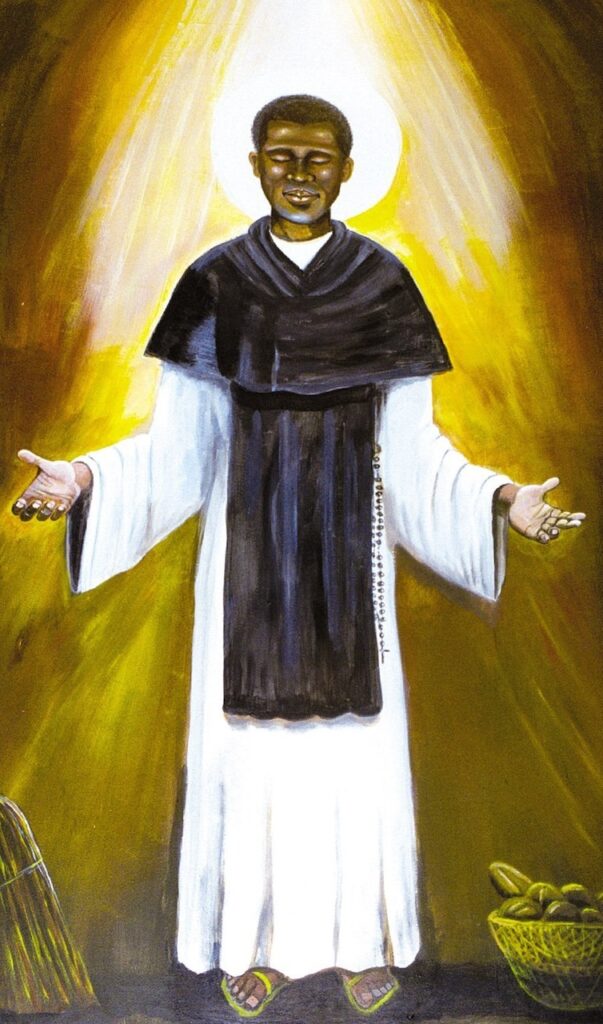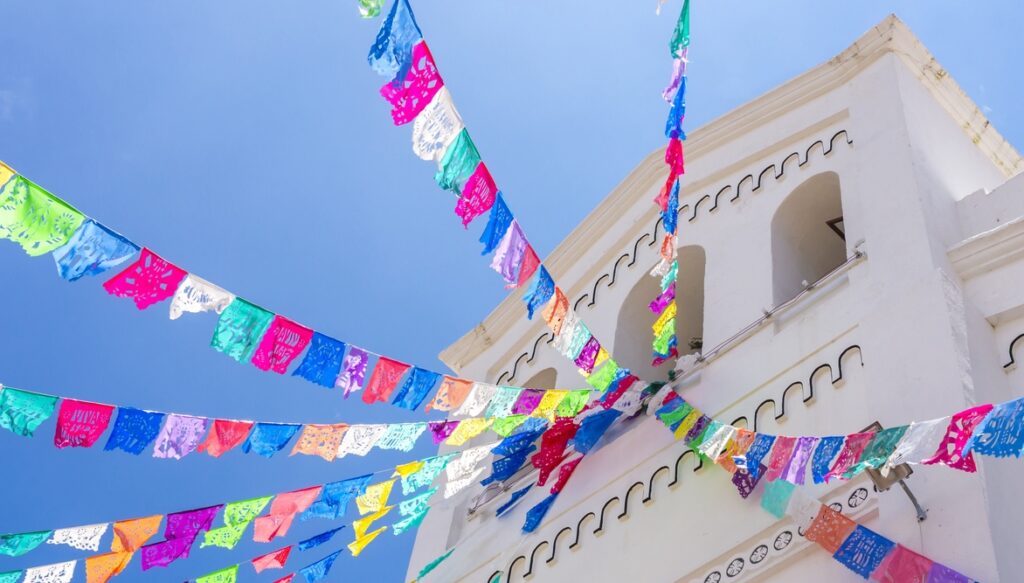Latin America has been the cradle of great saints who have left a deep mark on the Catholic Church through their witness and vocation. Their lives – marked by sacrifice, humility and dedication – reflect the religious fervor that has characterized our people. As we near the end of Hispanic Heritage Month, let us remember the lives of three Latin American saints whose lives, works and miracles continue to inspire the faith of our people.
St. Martin de Porres: The vocation of humility
 St. Martin de Porres, born in Lima, Peru, in 1579, is one of the saints in Latin America who inspires great devotion. He was the son of a Spanish nobleman, Juan de Porras de Miranda, and Ana Velázquez, a free woman of African descent from Panama who lived in Lima. Martin grew up in a context of poverty and marginalization due to his race. He is also known as the saint of the broom for being represented with a broom in his hand as a symbol of his humility.
St. Martin de Porres, born in Lima, Peru, in 1579, is one of the saints in Latin America who inspires great devotion. He was the son of a Spanish nobleman, Juan de Porras de Miranda, and Ana Velázquez, a free woman of African descent from Panama who lived in Lima. Martin grew up in a context of poverty and marginalization due to his race. He is also known as the saint of the broom for being represented with a broom in his hand as a symbol of his humility.
From a young age, he felt a deep call to serve others, especially the needy. He entered the Dominican convent as a layman, where he performed humble tasks for nine years such as cleaning and caring for the sick. However, his vocation went far beyond these daily tasks. He was admitted as a brother of the order in 1603. Three years later, he became a friar professing the vows of poverty, chastity and obedience.
Several miracles are attributed to him during his lifetime, such as the healing of the sick that the medicine of his time could not treat and the ability to bilocate, appearing in two places simultaneously. His life was a testimony of selfless service, deep humility and love for the most helpless.
After his death on November 3, 1639, it was many years before Pope St. John XXIII canonized him in Vatican City on May 6, 1962, before a crowd of 40,000 people from various parts of the world named him Patron Saint of Social Justice. “St. Martin, always obedient and inspired by his divine Master, lived among his brothers with that deep love born of pure faith and humility of heart,” the pontiff said during his homily at the Mass for the canonization.
“He loved people because he saw them as children of God and as his own brothers and sisters. Such was his humility that he loved them more than himself, and that he considered them better and more virtuous than himself,” the saintly pope said about St. Martin Porres.
“Martin excused the faults of another. He forgave the most bitter insults, convinced that he deserved greater punishments for his sins. He tried wholeheartedly to cheer up those who were embarrassed by their own faults, he comforted the sick, he provided clothes, food and medicine for the poor, he helped peasants, blacks and mulattoes who were then held as slaves. The people call him Martin, the good one.”
St. Rose of Lima: A consecrated heart
 St. Rose of Lima, the first canonized saint of the Americas, was born in Peru in 1586. From a very young age, Rosa – whose name was Isabel Flores de Oliva, but her mother called her Rosa because of her rosy face – showed a radical vocation to God, consecrating her life from an early age to prayer and penance. It is said that since she was a child, she made strong sacrifices for the love of Christ.
St. Rose of Lima, the first canonized saint of the Americas, was born in Peru in 1586. From a very young age, Rosa – whose name was Isabel Flores de Oliva, but her mother called her Rosa because of her rosy face – showed a radical vocation to God, consecrating her life from an early age to prayer and penance. It is said that since she was a child, she made strong sacrifices for the love of Christ.
Rosa lived as a consecrated laywoman (specifically Dominican lay tertiary). She and her brother had built a small hermitage in the garden of her house, where she dedicated long hours to prayer and to the care of the poor and sick. She had a concern for the poorest, especially the indigenous people who lived in extreme poverty and were mistreated by the rulers.
She is credited with several miracles, both during her lifetime and after her death, including the ability to heal the sick. In 1615, Lima was attacked by Dutch pirates, and it is attributed to her prayers and intercession that the invasion failed and the country’s capital was saved. Writings about her life say that she healed the sick with the image of the Child Jesus. She is also credited with healing smallpox patients with her prayers.
Her life of sacrifice and penance inspired generations, not only in Peru, but all over the world, becoming a symbol of deep love for God. She died at the age of 31 of tuberculosis. Because of her reputation for holiness, her funeral drew crowds from all walks of life.
After her death in 1617, thousands of pilgrims flocked to her tomb in the Convent of Santo Domingo in Lima. After her beatification, she was recognized as the Patron Saint of all of America and the Philippines.
Pope Clement X canonized her in 1671, and mentioned her zeal for the practice of penance. The feast day of Saint Rose of Lima was inscribed in the general Roman calendar in the year 1727, on August 30, which was the closest day to the anniversary of the saint’s death (August 24) that was not occupied by the celebration of another saint. Although a revision of the general Roman calendar made August 23 available, her feast day continues to be celebrated on August 30 in Peru.
St. Oscar Romero: The shepherd who gave his life for his flock
 St. Oscar Arnulfo Romero, Archbishop of San Salvador, is a saint of our times whose life and death reflect the call for social justice. Born in El Salvador in 1917, Romero was a man of deep faith who became the voice of the poor and oppressed during the darkest years of the civil war in San Salvador.
St. Oscar Arnulfo Romero, Archbishop of San Salvador, is a saint of our times whose life and death reflect the call for social justice. Born in El Salvador in 1917, Romero was a man of deep faith who became the voice of the poor and oppressed during the darkest years of the civil war in San Salvador.
He entered the seminary at the age of 13 and was ordained a priest at 24. His experience observing the injustices and violence suffered by his Salvadoran people led him to take a courageous and prophetic stance in defense of human rights.
On February 3, 1977, he was appointed by Pope St. Paul VI as Archbishop of San Salvador. Adriana Valle, researcher at the University of El Salvador, says that St. Romero was a great communicator; he called his faithful who listened to his messages to become “God’s microphones” to reproduce his denunciations.
“His Sunday homilies are a model of mass communication, effective and equanimous, which Monsignor Romero put at the service of the search for justice and truth,” Valle wrote, according to a university magazine.
In his last Sunday homily, a day before he was assassinated in 1980, he called on soldiers not to follow unjust orders and to stop repression against the people. His martyrdom made him a symbol of the struggle for justice and peace – and his intercession has been the source of numerous miracles, especially among those seeking solace in times of conflict.
On October 14, 2018, Monseñor Romero became El Salvador’s first saint. During the canonization Mass, Pope Francis said it was beautiful that St. Oscar Romero was canonized alongside St. Paul VI and the other saints, noting that he “left the security of the world, even his own safety, in order to give his life according to the Gospel, close to the poor and to his people, with a heart drawn to Jesus and his brothers and sisters.”
The lives of St. Martin de Porres, St. Rose of Lima, and St. Oscar Romero remind us that vocation is not only found in great gestures but also in the daily dedication to the service of others. These Latin American saints, through their testimony, invite us to live our faith with courage, love and commitment to the poorest and most abandoned.
As we close Hispanic Heritage Month and approach All Saints Day – and throughout the rest of the year – let us celebrate the spiritual richness of our peoples, recognizing the legacy of these saints and their call to serve others and seek holiness.

